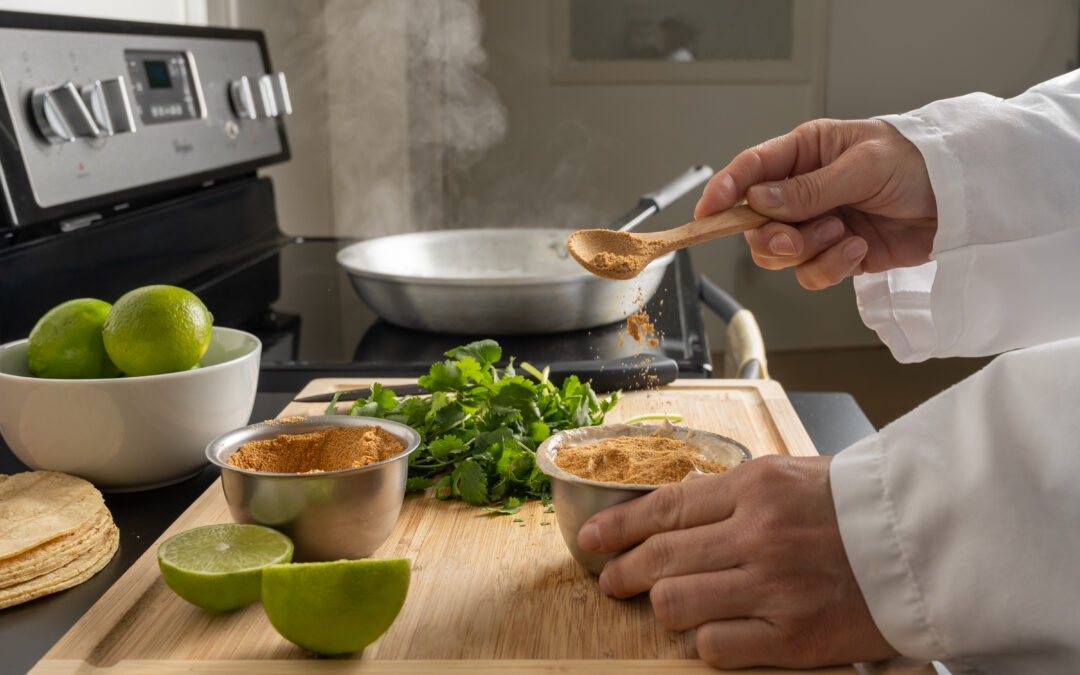At Pacific Spices, we celebrate spices for their unique ability to add flavor, aroma, color, and texture to dishes. While cooking with regional spices and herbs keep us connected to our roots, spices from around the world give us endless flavor possibilities and lead to innovation in the kitchen.
In today’s blog, we will help you get the most from your herbs and spices by teaching you some of the basics of cooking with spices.
We will cover the following topics:
- The 5 basic tastes
- How to store spices to preserve their flavor and quality
- Best practices for cooking and experimenting with spices
- How to innovate by pulling inspiration from global cuisine
Our goal is to help you build your arsenal of cooking tools with a few simple tips and tricks.
Get To Know Your Spices
Did you know that the reason certain foods taste good together is not random? It’s actually scientific! Certain food combinations are tasty because they share some of the same chemical compounds with each other and draw out one another’s best flavor qualities.
Read on to learn about each of the 5 basic tastes and their various properties.
The 5 Basic Tastes
Spices can be broken down into five main flavor categories: Bitter, salty, sour, sweet, and umami. In this section, we’ll talk about some spices and herbs within each flavor category and how to best use them in a recipe.
1. Bitter
Bitter herbs and spices at PSC:
- PSC Caraway
- PSC Bay Leaf
- PSC Turmeric
- PSC Thyme
- PSC Marjoram
Adding bitter herbs and spices to your recipes will help you balance sweet flavors, cut through rich foods, and enhance umami. Bitter herbs are also believed to improve digestion.
2. Salt
Salt products at PSC
- PSC Seasoning Salt
- PSC Garlic Parsley Salt
Salt is not just flavoring agent, it is an excellent flavor-balancer and an essential dietary nutrient.
Salty flavor balances sweetness and helps to mitigate the richness of other flavors such as bitterness. It is also a vital ingredient for cooking meat! Due to its unique chemical structure, salt has the ability to help extract proteins from meat, tenderize it, and aid in water-retention to keep meat from drying out.
We offer salt in a variety of different mesh sizes, as well as a number of salt-based blend options.
3. Sour
Sour herbs and spices at PSC:
- PSC Lemon Peels
- PSC Sumac
Sour herbs and spices contain organic acids which have the unique ability to increase salivation (and appetite), improve digestion, and stimulate taste buds.
Adding sour-flavored herbs and spices to your recipes can instantly help you brighten up a dish and balance the taste of rich foods.
4. Sweet
Sweet herbs and spices at PSC:
- PSC Nutmeg
- PSC Dill Seed
- PSC Caraway
- PSC Allspice
Adding sweet herbs and spices to your recipes can help you balance bitter and sour flavors and counteract spicy flavors.
5. Umami
Umami herbs and spices at PSC
- PSC Tomato Powder
- PSC Onion
- PSC Garlic
Umami spices increase salivation, deepen flavor, increase the feeling of mouth fullness, and have long lasting flavor.
Adding umami-flavored herbs and spices to your recipes can instantly bring balance and complexity to dishes.
Tips for Flavor Layering
Flavor layering is the culinary art of adding multiple flavors to a dish to create a more interesting and multi-dimensional flavor palette. By understanding the 5 basic flavor characteristics, you’ll have a baseline understanding that will help you experiment successfully with flavor layering in the kitchen. By pairing complimentary spices together, you can add variety, depth, and uniqueness to your recipes.
Some surefire combinations are:
- Bitter and umami
- Sweet and bitter
- Salty and sweet
- Sweet and sour
- Sour and umami
As you experiment, remember that rules are meant to be broken!
Cooking with Spices From Around the World
Locally grown ingredients are often the most readily accessible, inexpensive, and naturally available in any given region. Over time, blends made from locally sourced herbs and spices have come to represent the defining flavors of a country or region’s traditional cuisine.
- Indian cuisine is known for blends like garam masala and tandoori seasoning because they are commonly used in traditional Indian curries
- Mexico is known for spices like cumin and chili peppers because they are used to make regional dishes like Mexican rice
- Africa and the Middle East are known for spices like sumac, za’atar, and baharat for their use in popular street foods.
By incorporating exotic spices and blends in unexpected ways, you can bring newness to otherwise common dishes. When you cook,, take a moment to think about how you can bring global inspiration into your cooking.
At PSC, we love putting our own spin on traditional dishes. Here are some of our favorite culinary fusion recipes:
- Kung Pao Cauliflower
- Pumpkin Spice Churros
- Lamb Burger with Harissa Aioli
- Cardamom Berry Toaster Pastries
- Five Spice Turkey Lettuce Wraps
Try our recipes for yourself, or use them to inspire your own recipe creations.
Cooking with Spices
Adding spices during different stages of cooking can completely change how that spice influences a dish. When you are deliberate in how you season your dishes, you have better control over the final result.
Sprinkling spices over a freshly prepared meal will add a touch of flavor. However, when spices are added during the cooking process, the heat from the stove or oven draws out their essential oils and traps them in the food. This results in a more flavorful and aromatic dish.
The general rule of thumb is:
- Add whole, hearty, coarsely ground ingredients early. These spices might include sesame seeds, dried rosemary, whole ginger or turmeric, etc.
- Add fragile or finely ground ingredients late. These spices might include leafy herbs, minced garlic, etc.
It is important to note that whenever you toast your spices, you run the risk of burning them. To mediate this risk, always begin by heating the pan on medium heat. While toasting, keep the spices in motion. Using a spatula to move them around to ensure they toast evenly and do not burn.
How to Store Herbs and Spices
Here are the three main environmental factors that most impact the shelf life of dried herbs and spices:
- Light: Herbs and spices are best when stored in low light and in opaque containers.
- Humidity: Dry conditions are important when storing herbs and spices because products can become moldy when kept in humid conditions. It’s also imperative to always measure spices away from steam and to measure them with a dry utensil.
- Temperature: Dried herbs and spices are best kept in conditions under 70° Fahrenheit.
If you store herbs and spices properly, they will stay fresh, flavorful, and aromatic for longer.
Cooking with spices is so rewarding and one of the best ways to add flavor and interest to your recipes, whether you’re making a simple weeknight dinner or a feast for a special occasion.
Now that you understand the basics of cooking with spices, we hope you feel fully equipped to use spices in new ways to elevate your cooking and create delicious and unforgettable dishes. With a baseline understanding of the 5 flavor categories, an excitement for spices from around the globe, and a firm adherence to the best practices for spice storage, we’re confident you’ll reap the benefits right away.
With PSC’s wide selection of high-quality spices, herbs, and blends, the possibilities are endless! Contact us for a full list of our spices and spice blends.

